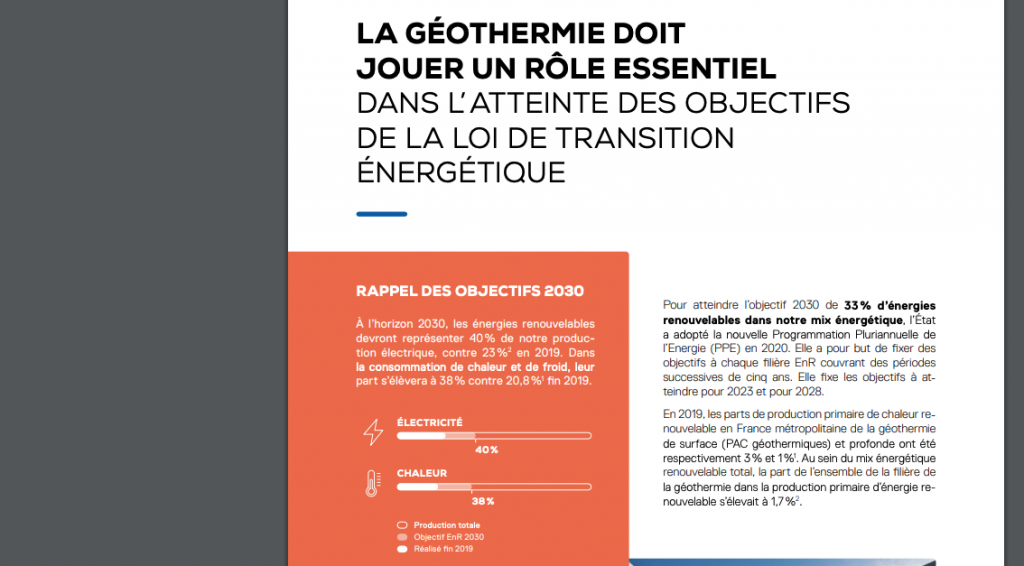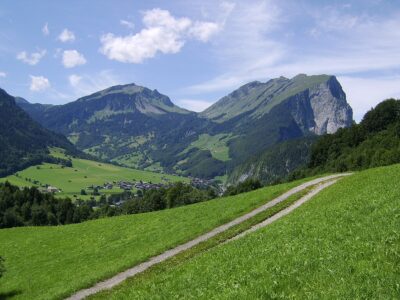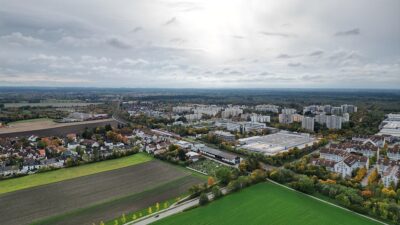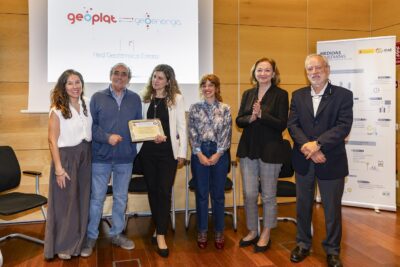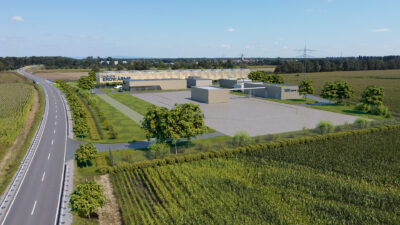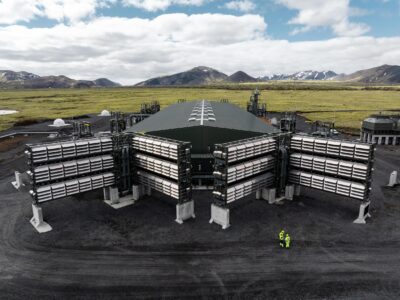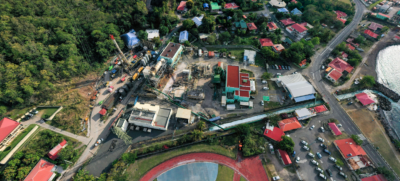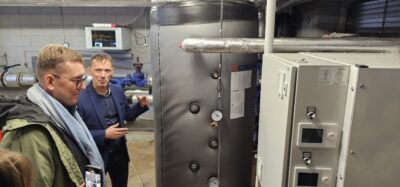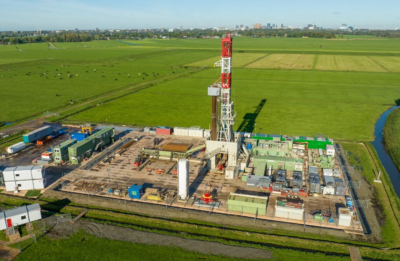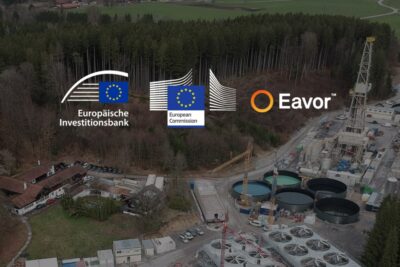Geothermal energy in France – what is needed for tapping its potential?
French Renewable Energy Trade Association SER has released a concise and detailed overview on the different use of geothermal energy, its potential and required actions for the sector to tap its potential for the greater benefit of reaching renewable energy goals in France.
The French Renewable Energy Trade Association (Syndicat des énergies renouvelables, SER) has just released a very comprehensive dossier on geothermal energy – both deep and shallow geothermal, looking at what would be the required conditions for geothermal as part of a new model for energy in France.
The report concludes that geothermal energy will play an essential role in achieving the objective in the energy transition in France.
To achieve the 2030 target of 33% of renewable energy in the country’s energy mix, the State adopted the new Multi-annual Programming of Energy (PPE) in 2020. Its purpose is to set objectives for each renewable energy sector covering periods successive five years. It sets the objectives to be achieved for 2023 and 2028.
In 2019, the shares of primary production of renewable heat in metropolitan France from geothermal energy surface (geothermal heat pumps) and deep were respectively 3% and 1%. Within the energy mix total renewable, the share of the entire geothermal energy in the primary production of renewable energy amounted to 1.7%.
The report describes that the pace of geothermal development is still insufficient for achieving the 2023 objectives of the state multi-year energy program (Programmation Pluriannuelle de l’Energie (PPE) )
Heat production from surface/ shallow geothermal energy
Heat production by surface geothermal energy represents three quarters of the energy produced in France by geothermal energy. In addition, the geothermal energy of surface is accessible on almost the entire territory French. Despite its strong assets and the progress made by the sector, the number of new annual installations is in free fall, from 19,430 in 2008 to 2,582 in 2019, and France is lagging behind his neighbors. Without additional measures taken quickly, surface geothermal energy will not be able to reach the objectives set by the PPE.
If positive steps have been taken in recent years, they are not enough to revitalize the sector. In the event that the necessary actions are companies to allow the maintenance of the Geothermal heat pump at its current level, then its growth, the Geothermal Commission of the SER considers that
we could reach 750ktep of heat production from surface geothermal energy in 2030, against 386ktep in 2019.
Potential for heat production from deep geothermal resources still very much unused
France was one of the pioneer countries in the development of geothermal energy with the development of the Paris Basin (aquifer of the Dogger) which still presents the highest density of operations in the world low-energy geothermal energy in operation. On the whole of its basement, our country has very high geothermal potential important, of which only a tiny part is now exploited.
Without new rapid and effective measures, the current rate of development of the deep geothermal sector low energy will not achieve the heat production objectives of the Schedule Pluriannuelle de l’Energie (PPE) adopted in 2020.
The SER Geothermal Commission establishes its trend scenario by maintaining an average rate of 50MWth / year between 2018 and 2023 and 65MWth / year between 2023 and 2030.
If the necessary measures are taken to allow the development and growth of this sector, SER Geothermal Commission estimates that we could reach 530ktep of heat production in 2030, against 153ktep in 2018.
Electricity production from deep geothermal resources
If the necessary measures are taken to release the potential of the high-energy geothermal sector, Geothermal Commission of the SER estimates that the installed geothermal power generation capacity could reach 53 MW in metropolitan France in 2030. This will include, in particular, reintroduction of a development objective of deep geothermal energy. The operators of the sector have, to date, invested more than EUR 100 million in research and development and in construction of production plants.
The completion of the first power plants should make it possible to consolidate the French sector, which has significant potential on the national territory and internationally. Deep geothermal energy also offers the opportunity to extract the lithium present in geothermal waters. Significant extraction of this resource from around ten power plants geothermal energy could represent the equivalent of 6% of global lithium production (a major industrial issue, particularly for electric mobility).
So what is required to release the potential of all the elements of geothermal energy utilisation?
In the short-term SER sees the need to implement the following measures listed in the PPE in favour of geothermal energy.
- Measure 1: Carry out a national campaign of exploration of deep aquifers known and speed up related work to the extension of the SAF guarantee.
- Measure 2:Set up at least one facilitator geothermal specialist by administrative region and put in place of heat / cold animators renewable to a lower mesh
In addition, the SER offers the following measures for the development of geothermal energy resources optimally:
- Measure 3: Lift regulatory brakes and lighten geothermal project procedures surface area subject to the mining code in adapting the geothermal framework of Minime Importance (GMI)
- Measure 4: Reintroduce economic support and national development goals for the production of electricity from deep geothermal energy, while developing a French sector for the extraction of lithium from geothermal waters
- Measure 5: Establish thermal regulations ambitious for new buildings
- Measure 6: Reinstate deciles 9 and 10 in the public aid for renovation
- Measure 7: Develop geothermal cooling networks by supporting the production of renewable cold
- Measure 8: Benefit cooling networks renewable at the same reduced VAT rate than renewable heat networks
Proposed revival of geothermal through the “Chaleur” Fund
Following the health crisis linked to COVID-19, the French economic recovery plan is an opportunity to give a significant boost to development
renewable energies. The establishment of the Heat Fund by ADEME ten years ago has enabled the geothermal energy not to extinguish itself. Faced with the delay of geothermal energy in France, in particular compared to its European neighbours such as Switzerland or Germany, the geothermal commission of the SER proposes, through the Heat Fund, actions that will help release the full potential of geothermal energy in the renewable energy mix.
SER proposes several action items that cross over to both sectors, shallow and deep geothermal
Specific actions for shallow geothermal
- Action 1: Treat run-of-river geothermal projects – essentially allow for more frequent calls for projects under the AAP process not just once per year
- Action 2: Qualify the term “exemplary operation”and” demonstration” – essentially allowing for an assessment of eligibility of a project under these terms depending on te contribution to the sector
- Action 3: Improve communication around the heat fund
Specific actions for the deep geothermal sector
- Action 4: Include issuers in the work base for the production of heat and cold
- Action 5: Improve help for assemblies in thermo-fridge-pump (TFP)
- Action 6: Improve the geocooling bonus
- Action 7: Create a Geothermal Innovation Fund
- Action 8: Develop exploration in unknown areas
- Action 9: Help model funding based on the potential impact to the local economy
Source: “Géothermie : les conditions de la réussite pour construire le nouveau modèle énergétique francais” (pdf), SER
